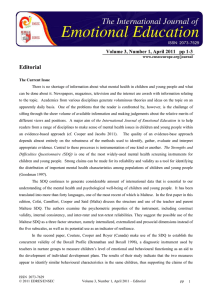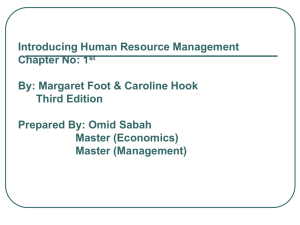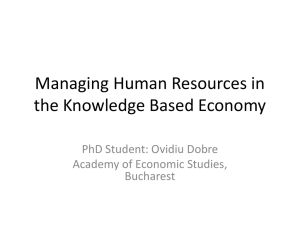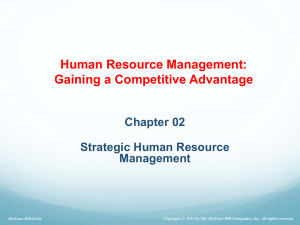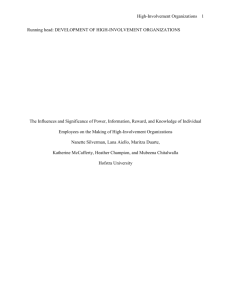Peter Boxall - University of Auckland
advertisement
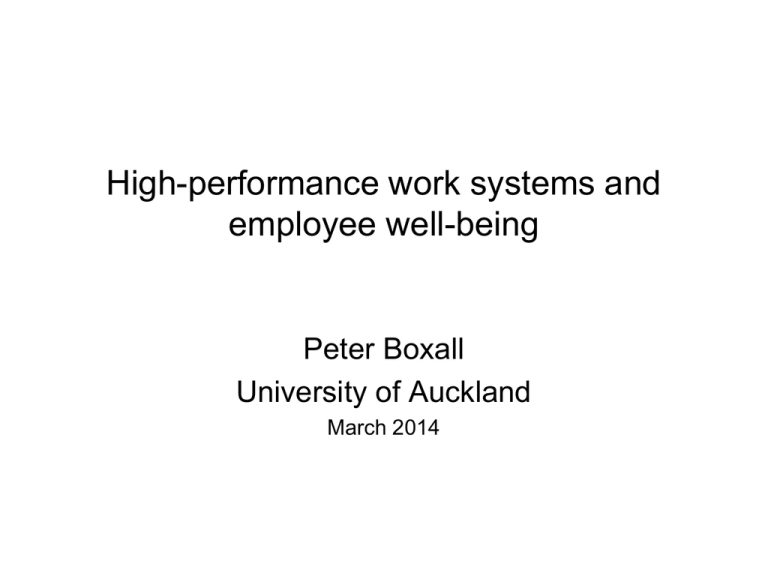
High-performance work systems and employee well-being Peter Boxall University of Auckland March 2014 Goal and structure • To discuss the current state of HPWS research and the implications of two recent studies of worker experiences • Presentation structure: (1) HPWSs: concepts and key issues (2) theory of high-involvement work processes (3) two studies on HIWPs and employee well-being (4) conclusion: research trajectories 2 (1) ‘High-performance work systems’ • a rallying point for interest in mutually beneficial workplace reform e.g. CSAW 1990; Appelbaum et al 2000; Eurofound 2012 • but a non-descriptive and presumptuous term – what is highly performing is not self-evident and defining a model of HRM at the ‘practice’ level is dangerous (Purcell 1999; Boxall and Macky 2009) – ‘high commitment’ (Walton 1985) and ‘high involvement’ (Lawler 1986) are more descriptive terms 3 Key issues: employer side • what and why: the ‘law of context’ – what are the strategic complementarities and what are the costbenefits of different models of HRM? e.g. Porter & Siggelkow 2008; Godard 2004; Kaufman & Miller 2011 – low-involvement models of HRM, for example, are common in standardised services e.g. Korzcynski et al 2000; Boxall et al 2011 • how and for whom: variability in processes, perceptions, attributions and outcomes inside the ‘black box’ – irrespective of the model chosen e.g. Purcell 1999; Nishii et al 2008 4 Key issues: worker side • ‘high-strain’ jobs/work intensification – e.g. Karasek and Theorell 1990; Green 2006 • ‘employment strain’/rising insecurity – e.g. Ramsay et al 2000; Lewchuck et al 2008 • promises versus reality in ‘disconnected capitalism’ – Thompson 2004 5 (2) Theory of high-involvement work systems • empowerment, reinforced by information, reward and knowledge (‘PIRK’), enhances performance (Lawler 1986) – through ‘cognitive’ and ‘motivational’ paths (Vandenberg et al 1999) • employee well-being should improve because of – better job characteristics (Hackman and Oldham 1980), especially autonomy or control (e.g. Gallie 2007, Deci and Ryan 2000) – greater extrinsic reward from mobilising ‘discretionary effort’ (Appelbaum et al 2000) • but what about work intensification? 6 (3) National-level study (Boxall and Macky, Work, Employment and Society, forthcoming) Random telephone survey of 1016 New Zealand employees, conducted in 2009 (n = 926 usable) 31.5% response rate; sample mirrors the population 7 Conceptual framework High-involvement work processes Employee outcomes Power-autonomy Job satisfaction Information (two-way communication) Rewards (well linked to performance) Fatigue Stress Work-life imbalance Knowledge (skill development and training opportunities) Work intensification Controls Hours worked Job quality variables Role overload Demographics Time demands 8 Hierarchical regression: job satisfaction Variables Job Fatigue Final Model -.134*** Trust in management Perceived Job insecurity .209*** -.091** Power-autonomy Rewards Development .170*** .093* .102** R2 Model F .373 21.49*** 9 Hierarchical regression: work-related stress Variables Age Tenure (log) Final model -.072* .098** Job Fatigue Work-life imbalance .147*** .165*** Usual hours worked Role overload .146*** .282*** Power-autonomy Information Rewards Development .003 .083 .023 -.051 R2 Model F .379 22.05*** 10 Hierarchical regression: work-life imbalance Variables Gender Job Stress Job Fatigue Usual hours worked Role overload Time demands Final Model .074** .118*** .202*** .231*** .167*** .312*** Power-autonomy Information Rewards -.071* -.071* -.072* R2 Model F .556 45.09*** 11 National-level findings • Worker-perceived empowerment enhances well-being or is, at the least, neutral, while long hours, role overload and unwanted time demands diminish it – resonates with analysis of WERS 2004 (Wood et al 2012) and the British Skills Survey 2006 (Gallie 2013) • Workers benefit from ‘HPWSs’ when: (1) their autonomy, and supportive processes, genuinely improve; (2) work pressures are reasonable and work-life balance is not undermined 12 Company-level study (2011) (Boxall, Hutchison and Wassenaar, under review) • a distribution company that has tried to reduce the impact of a Taylorist work design by enhancing worker involvement and by investment in training • studying the mediators of skill utilisation and intrinsic motivation, using SEM • 285 useable responses (response rate of 46%) 13 Findings: SEM Power Information Affective commitment Skill utilisation Job satisfaction Reward Knowledge Intrinsic motivation Stress 14 (4) Conclusion: research trajectories • describing the models of HRM that managers pursue within firms’ production systems, business/financial strategies, and the societal/global environment (e.g. Thompson 2004, 2011; Kaufman and Miller 2011) • analysing managers’ and workers’ psychological, physical and social experience of these models, including their strategies and outcomes (e.g. Guest 1999; Rosenthal 2004; McBride 2008) 15 … • analysing the strategic tensions involved and the scope for greater mutuality (Boxall 2013) – e.g. work standardisation versus individual development – e.g. organisational flexibility versus employment security – e.g. “engagement” versus effort-reward and work-life balance • improving the employment relationship through – enhanced involvement and skill utilisation (e.g. Felstead et al 2010)? – better ‘combining of career and care’ (e.g. van Engen et al 2012)? – improved sociality among older workers (e.g. Sanders et al 2011)? 16 References Appelbaum, E., Bailey, T., Berg, P. and Kalleberg, A. (2000) Manufacturing Advantage: Why High-Performance Work Systems Pay Off, Ithaca: ILR Press. Boxall, P. (2013) ‘Mutuality in the management of human resources: assessing the quality of alignment in employment relationships’. Human Resource Management Journal 23(1): 3-17. Boxall, P. and Macky, K. (2009) ‘Research and theory on high-performance work systems: Progressing the high-involvement stream’. Human Resource Management Journal 19(1): 3-23. Boxall, P., Ang, S.H. and Bartram, T. (2011) ‘Analysing the “black box” of HRM: uncovering HR goals, mediators and outcomes in a standardised service environment’. Journal of Management Studies, 48, 7, 1504–1532. Commission on the Skills of the American Workforce (CSAW) (1990) America's Choice: High Skills or Low Wages! Rochester, NY: National Center on Education and the Economy. Deci, E. and Ryan, R. (2000) ‘The “what” and “why” of goal pursuits: human needs and the self-determination of behavior’. Psychological Inquiry 11(4): 227-68. Eurofound (2012) Work Organisation and Innovation. European Foundation for the Improvement of Living and Working Conditions. Felstead, A., Gallie, D., Green, F. and Zhou, Y. (2010) ‘Employee involvement, the quality of training and the learning environment: an individual level analysis’. International Journal of Human Resource Management, 21(10): 1667-1688. Gallie, D (2007) Employment Regimes and the Quality of Work. Oxford: Oxford University Press. Gallie, D (2013) ‘Direct participation and the quality of work’. Human Relations 66(4): 453–473. Godard, J. (2004) ‘A critical assessment of the high-performance paradigm’. British Journal of Industrial Relations, 42: 2, 349-378. Green, F. (2006) Demanding Work: The Paradox of Job Quality in the Affluent Economy, Princeton, NJ: Princeton University Press. Guest, D. (1999) ‘Human resource management: the worker’s verdict’. Human Resource Management Journal 9(3): 5-25. Hackman, J. and Oldham, G. (1980) Work Redesign. Reading, MA: Addison-Wesley. Karasek, R. and Theorell, T. (1990) Healthy Work: Stress, Productivity and the Reconstruction of Working Life. New York: Basic Books. Kaufman, B. and Miller, B. (2011) ‘The firm’s choice of HRM practices: Economics meets strategic human resource management’. Industrial and Labor Relations Review 64(3): 526–557. Korczynski, M. (2001) ‘The contradictions of service work: call centre as customer-oriented bureaucracy’, in Sturdy, A., Grugulis, I. and Willmott, H. (Eds), Customer Service: Empowerment and Entrapment. Basingstoke: Palgrave Macmillan. Lawler, E. (1986) High-involvement management: Participative strategies for improving organizational performance. San Francisco: Jossey-Bass. Lewchuk, W., Clarke, M. and de Wolff, A. (2008) ‘Working without commitments: precarious employment and health’. Work, Employment and Society 22(3): 387–406 McBride, J. (2008) ‘The limits of high performance work systems in unionised craft-based work settings’. New Technology, Work and Employment 23(3): 213-28. Nishii, L. Lepak, D. and Schneider, B. (2008) ‘Employee attributions of the “why” of HR practices: their effects on employee attitudes and behaviors, and customer satisfaction’. Personnel Psychology 61: 503-45. Porter, M. and Siggelkow, N. (2008) ‘Contextuality within activity systems and sustainability of competitive advantage’. Academy of Management Perspectives 22(2): 34-56. Purcell, J. (1999) ‘The search for “best practice” and “best fit”: chimera or cul-de-sac?’, Human Resource Management Journal, 9: 3, 26-41. Ramsay, H., Scholarios, D. & Harley, B. (2000) ‘Employees and high-performance work systems: testing inside the black box’, British Journal of Industrial Relations, 38: 4, 501-31. Rosenthal, P. (2004) ‘Management control as an employee resource: the case of front-line service workers’. Journal of Management Studies, 41, 601–22. Sanders, J., Dorenbosch, L., Grundemann, R. and Blonk, R. (2011) ‘Sustaining the work ability and work motivation of lower-educated older workers: directions for work redesign’. Management Revue 22(2): 132-50. Thompson, P. (2004) ‘Disconnected capitalism: or why employers can’t keep their side of the bargain’. Work, Employment and Society 17(2): 359-78. Thompson, P. (2011) ‘The trouble with HRM’. Human Resource Management Journal 21(4): 355–367 Vandenberg, R., Richardson H. and Eastman L. (1999) ‘The impact of high involvement work processes on organisational effectiveness: a second order latent variable approach’. Group and Organisational Management 24(1): 300-339. Van Engen, M., Vinkenburg, C. and Dikkers, J. (2012) ‘Sustainability in combining career and care: challenging normative beliefs about parenting’. Journal of Social Issues 68(4): 645-64. Walton, R. (1985). ‘From control to commitment in the workplace’, Harvard Business Review, 63: 2, 77-84. Wood, S., Van Veldhoven, M., Croon, M. and de Menezes, L. (2012) ‘Enriched job design, high involvement management and organizational performance: the mediating roles of job satisfaction and well-being’. Human Relations 65(4): 419–445. 17


